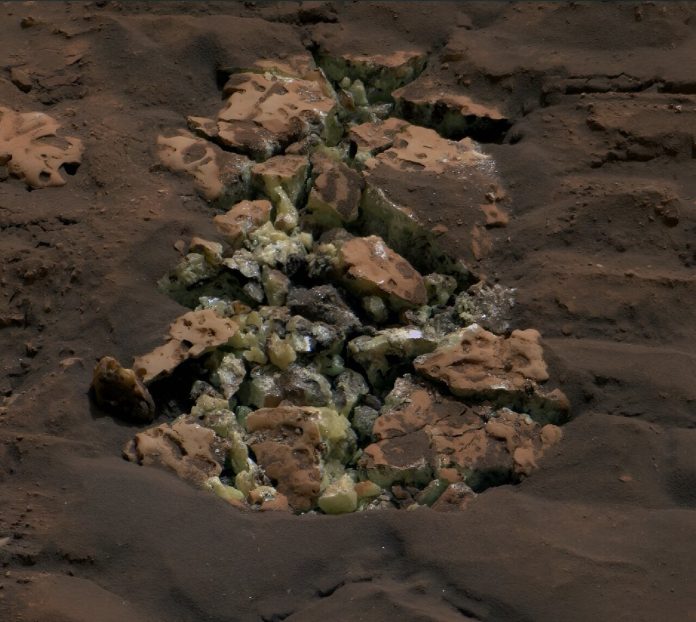
Scientists were astonished on May 30 when NASA’s Curiosity rover uncovered something never seen before on Mars: bright yellow sulfur crystals inside a rock it drove over.
This unexpected finding has scientists excited and puzzled about the Red Planet’s history and conditions.
Since October 2023, Curiosity has been exploring a region rich in sulfates—salts that form as water evaporates.
Typically, the rover has detected sulfur mixed with other materials. However, this rock revealed pure sulfur, a rare find.
Scientists are unsure how this pure sulfur relates to the other sulfur-based minerals found in the area.
Sulfur is often associated with the smell of rotten eggs due to hydrogen sulfide gas, but pure sulfur is odorless. It forms under specific conditions not previously linked to this part of Mars. Curiosity discovered an entire field of these bright sulfur rocks.
“Finding a field of stones made of pure sulfur is like finding an oasis in the desert,” said Ashwin Vasavada, Curiosity’s project scientist at NASA’s Jet Propulsion Laboratory.
“It shouldn’t be there, so now we have to explain it. Discovering strange and unexpected things is what makes planetary exploration so exciting.”
This sulfur discovery is one of several Curiosity has made while exploring Gediz Vallis channel. This channel winds down Mount Sharp, a 3-mile-tall (5-kilometer-tall) mountain that Curiosity has been climbing since 2014.
Each layer of Mount Sharp represents a different period in Mars’ history. Curiosity’s mission is to study these layers to understand when and where Mars might have had the conditions necessary for microbial life.
Gediz Vallis channel was spotted from space years before Curiosity’s launch and was one of the main reasons scientists wanted to explore this part of Mars.
They believe the channel was carved by flowing water and debris, which left a ridge of boulders and sediment extending 2 miles down the mountainside.
Since Curiosity arrived at the channel earlier this year, scientists have been investigating whether ancient floods or landslides created the large debris mounds found there. Curiosity’s latest findings suggest that both played a role.
Some debris mounds were likely formed by violent water flows, while others appear to have been created by landslides. This conclusion is based on the types of rocks found in the debris. Water-carried rocks tend to be rounded, while landslide debris contains more angular rocks.
Water also soaked into the material that settled in the channel, causing chemical reactions that bleached some rocks white, creating “halo” shapes. Over time, erosion from wind and sand has revealed these halos.
“This was not a quiet period on Mars,” said Becky Williams from the Planetary Science Institute in Tucson, Arizona. “There was a lot of activity here, including energetic floods and boulder-rich flows.”
In May, Curiosity captured images of rocks with pale edges, similar to markings on Earth where groundwater causes chemical reactions in rocks. The science team has been eager to take a rock sample from the channel to learn more.
On June 18, they found a large rock nicknamed “Mammoth Lakes” suitable for drilling. Curiosity’s drill bored its 41st hole, collecting powderized rock for analysis to determine its composition.
Curiosity has since moved on from Mammoth Lakes, continuing its journey through Gediz Vallis channel in search of more surprises. Each discovery helps scientists piece together the complex history of Mars and its potential for past life.
Source: NASA.



